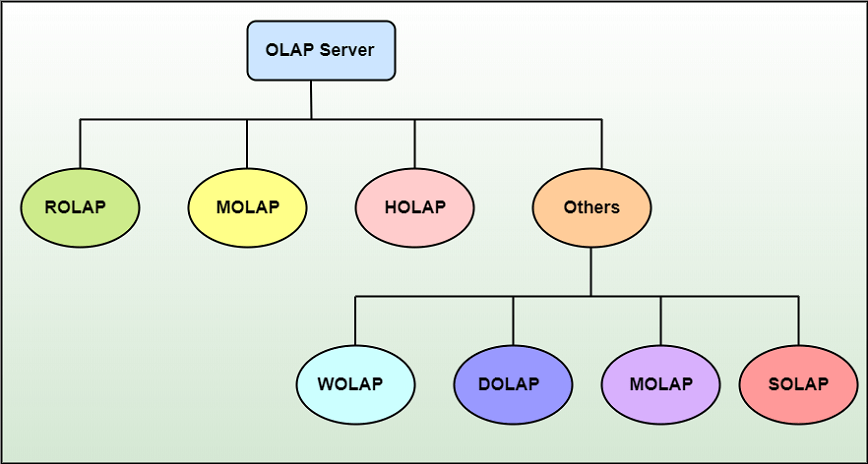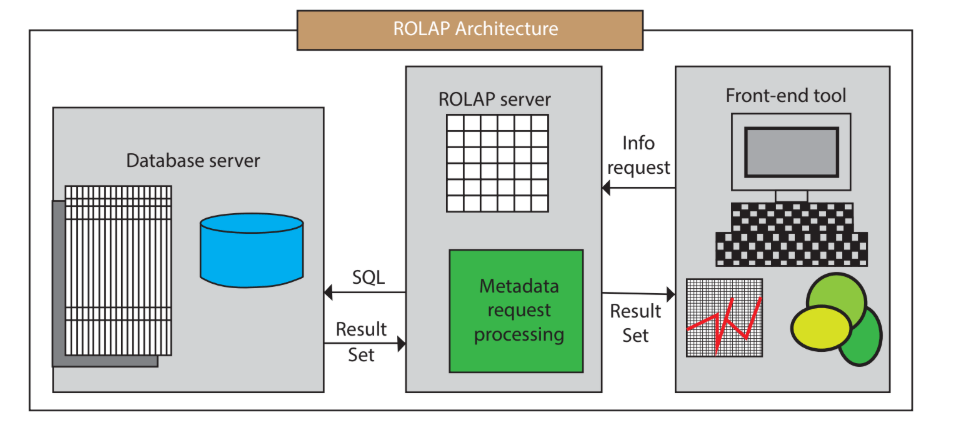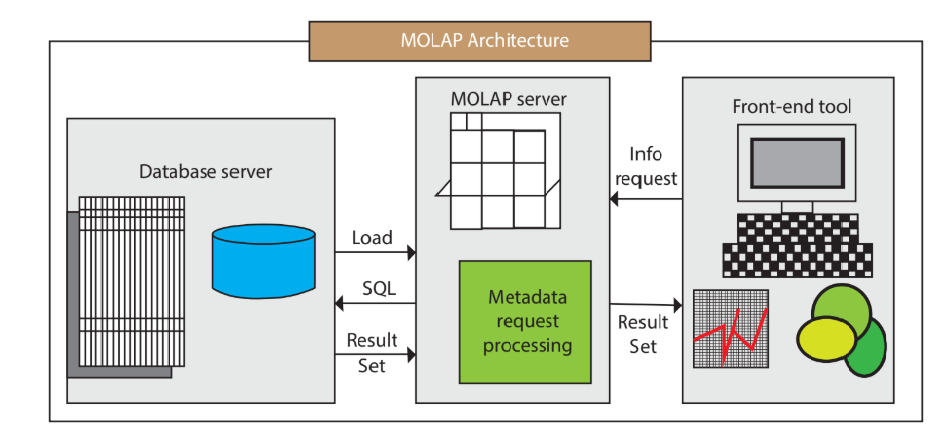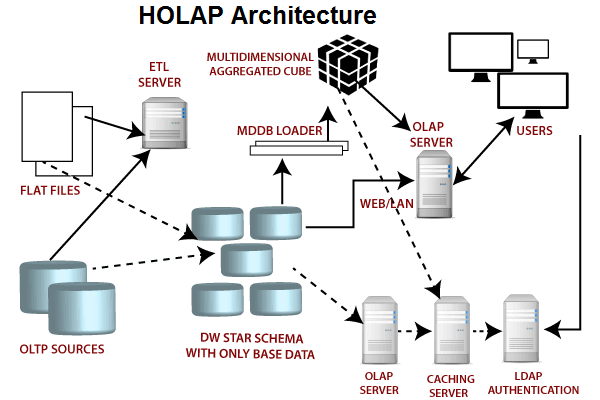Types of OLAPThere are three main types of OLAP servers are as following: 
ROLAP stands for Relational OLAP, an application based on relational DBMSs. MOLAP stands for Multidimensional OLAP, an application based on multidimensional DBMSs. HOLAP stands for Hybrid OLAP, an application using both relational and multidimensional techniques. Relational OLAP (ROLAP) ServerThese are intermediate servers which stand in between a relational back-end server and user frontend tools. They use a relational or extended-relational DBMS to save and handle warehouse data, and OLAP middleware to provide missing pieces. ROLAP servers contain optimization for each DBMS back end, implementation of aggregation navigation logic, and additional tools and services. ROLAP technology tends to have higher scalability than MOLAP technology. ROLAP systems work primarily from the data that resides in a relational database, where the base data and dimension tables are stored as relational tables. This model permits the multidimensional analysis of data. This technique relies on manipulating the data stored in the relational database to give the presence of traditional OLAP's slicing and dicing functionality. In essence, each method of slicing and dicing is equivalent to adding a "WHERE" clause in the SQL statement. Relational OLAP ArchitectureROLAP Architecture includes the following components

Relational OLAP (ROLAP) is the latest and fastest-growing OLAP technology segment in the market. This method allows multiple multidimensional views of two-dimensional relational tables to be created, avoiding structuring record around the desired view. Some products in this segment have supported reliable SQL engines to help the complexity of multidimensional analysis. This includes creating multiple SQL statements to handle user requests, being 'RDBMS' aware and also being capable of generating the SQL statements based on the optimizer of the DBMS engine. AdvantagesCan handle large amounts of information: The data size limitation of ROLAP technology is depends on the data size of the underlying RDBMS. So, ROLAP itself does not restrict the data amount. DisadvantagesPerformance can be slow: Each ROLAP report is a SQL query (or multiple SQL queries) in the relational database, the query time can be prolonged if the underlying data size is large. Limited by SQL functionalities: ROLAP technology relies on upon developing SQL statements to query the relational database, and SQL statements do not suit all needs. Multidimensional OLAP (MOLAP) ServerA MOLAP system is based on a native logical model that directly supports multidimensional data and operations. Data are stored physically into multidimensional arrays, and positional techniques are used to access them. One of the significant distinctions of MOLAP against a ROLAP is that data are summarized and are stored in an optimized format in a multidimensional cube, instead of in a relational database. In MOLAP model, data are structured into proprietary formats by client's reporting requirements with the calculations pre-generated on the cubes. MOLAP ArchitectureMOLAP Architecture includes the following components

MOLAP structure primarily reads the precompiled data. MOLAP structure has limited capabilities to dynamically create aggregations or to evaluate results which have not been pre-calculated and stored. Applications requiring iterative and comprehensive time-series analysis of trends are well suited for MOLAP technology (e.g., financial analysis and budgeting). Examples include Arbor Software's Essbase. Oracle's Express Server, Pilot Software's Lightship Server, Sniper's TM/1. Planning Science's Gentium and Kenan Technology's Multiway. Some of the problems faced by clients are related to maintaining support to multiple subject areas in an RDBMS. Some vendors can solve these problems by continuing access from MOLAP tools to detailed data in and RDBMS. This can be very useful for organizations with performance-sensitive multidimensional analysis requirements and that have built or are in the process of building a data warehouse architecture that contains multiple subject areas. An example would be the creation of sales data measured by several dimensions (e.g., product and sales region) to be stored and maintained in a persistent structure. This structure would be provided to reduce the application overhead of performing calculations and building aggregation during initialization. These structures can be automatically refreshed at predetermined intervals established by an administrator. AdvantagesExcellent Performance: A MOLAP cube is built for fast information retrieval, and is optimal for slicing and dicing operations. Can perform complex calculations: All evaluation have been pre-generated when the cube is created. Hence, complex calculations are not only possible, but they return quickly. DisadvantagesLimited in the amount of information it can handle: Because all calculations are performed when the cube is built, it is not possible to contain a large amount of data in the cube itself. Requires additional investment: Cube technology is generally proprietary and does not already exist in the organization. Therefore, to adopt MOLAP technology, chances are other investments in human and capital resources are needed. Hybrid OLAP (HOLAP) ServerHOLAP incorporates the best features of MOLAP and ROLAP into a single architecture. HOLAP systems save more substantial quantities of detailed data in the relational tables while the aggregations are stored in the pre-calculated cubes. HOLAP also can drill through from the cube down to the relational tables for delineated data. The Microsoft SQL Server 2000 provides a hybrid OLAP server. 
Advantages of HOLAP
Disadvantages of HOLAP
Other TypesThere are also less popular types of OLAP styles upon which one could stumble upon every so often. We have listed some of the less popular brands existing in the OLAP industry. Web-Enabled OLAP (WOLAP) ServerWOLAP pertains to OLAP application which is accessible via the web browser. Unlike traditional client/server OLAP applications, WOLAP is considered to have a three-tiered architecture which consists of three components: a client, a middleware, and a database server. Desktop OLAP (DOLAP) ServerDOLAP permits a user to download a section of the data from the database or source, and work with that dataset locally, or on their desktop. Mobile OLAP (MOLAP) ServerMobile OLAP enables users to access and work on OLAP data and applications remotely through the use of their mobile devices. Spatial OLAP (SOLAP) ServerSOLAP includes the capabilities of both Geographic Information Systems (GIS) and OLAP into a single user interface. It facilitates the management of both spatial and non-spatial data. |
 For Videos Join Our Youtube Channel: Join Now
For Videos Join Our Youtube Channel: Join Now
Feedback
- Send your Feedback to [email protected]
Help Others, Please Share










